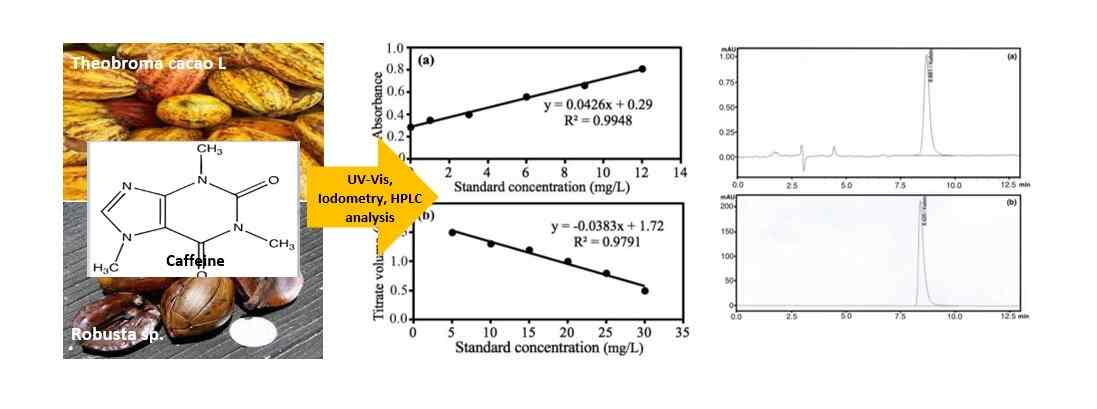Performance of Caffeine Content Analysis in Robusta sp and Theobroma cacao L using Iodometry, UV-Vis Spectrophotometry and High Performance Liquid Chromatography
Abstract

Caffeine is a xanthine alkaloid compound found in Robusta sp and Theobroma cacao L. The caffeine extract was obtained by evaporating CHCl3 using a rotary evaporator and determine its content using iodometry, UV-Vis spectrophotometry and High Performance Liquid Chromatography, then validated by measurement methods. The iodometric caffeine content in Theobroma cacao L is 900 mg/kg while UV-Vis spectrophotometry is 4,000 mg/kg, and for HPLC in Robusta sp is 19,475 mg/kg. The iodometry performance gives the linearity value, R2 of 0.9791. The precision values at 5.0 mg/L and 15.0 mg/L are 4.6% and 8.3%. Accuracy for 5.0; 10.0; and 15.0 mg/L are 106%, 100% and 94% respectively. The performance of UV-Vis spectrophotometry gives linearity value, R2 of 0.9948. The precision value at 1.0 mg/L and 6.0 mg/L gives the variance coefficient value of 4.2% and 1.2%, while the accuracy at 1.0 mg/L and 6.0 mg/L are 99% and 101%.
References
[1] Gebeyehu, B.T. and Bikila, S.L., Am. J. Appl. Chem. 2015, 3(2), 69-76.
[2] Papanov, S., Pankova, S., Ivanov, K., Ivanova, S., Doncheva, D. and Pencheva, I., Int. J.
Nutr. Food Sci. 2015, 4, 9-13.
[3] Abbood, A. and Aldiab, D., J. Chem. Pharm. Sci. 2017, 10(3), 1174-1179.
[4] Grujic-Letic, N., Rakic, B., Sefer, E., Milanovic, M., Niksic, M., Vujic, I. and Milic, N.,
Maced. Pharm. Bull. 2016, 62(1), 77-84.
[5] Belay, A., ture, K., Redi, M. and Asfaw, A., Food Chem. 2008, 108(1), 310-315.
[6] Zarwinda, I. and Sartika, D., Lantanida Journal, 2018, 6(2), 180-191.
[7] Nyirahabimana, F. and Uwimana, P., Int. J. Food Sci. Biotechnol., 2017, 2(2), 51-55.
[8] Amos-Tautua, W. and Diepreye, E., Adv. J. Food Sci. Technol, 2014, 6(2), 155-158.
[9] Wijiyanti, D. and Huda, T., JC-T: Jurnal Kimia dan Terapannya, 2017, 1(2), 22-24.
[10] Yazid, E.A., J. Trop. Pharm. Chem., 2019, 4(6), 271-280.
[11] Pasia, I.N., Kiriakou, I. and Proestos, C., Antioxidants, 2017, 6(3), 67.
[12] Sethuraman, S. and Radhakrishnan, K., Int. J. Novel Trends Pharm. Sci. 2013, 3(4),
82-86.
[13] Dioha, I.J., Olugbemi, O., Onuegbu, T.U. and Shahru, Z., Int. J. Biol. Chem. Sci., 2011,
5(5), 2180-2184.
[14] Attih, E.E., Essien, E.E., Eseyin, O.A., Oladimeji, H.O. and Igboasoiyi, A.C.,
NIJOPHASR, 2012, 1(2), 74-82.
[15] Asmara, A.P., Elkawnie, 2016, 2(1), 37-50.
[16] Artanti, A.N., Nikmah, W.R., Setiawan, D.H. and Prihapsara, F., JPSCR, 2016, 1(1),
37-44.
[17] Tayeb, M.A., Ismail, B.S., Mardiana-Jansar, K. and Ta, G.C., Sains Malaysiana, 2016,
45(2), 237-245.
[18] Ozkan, S.A., Pharm. Sci. 2018, 24, 1-2.
[19] Sankar, P.R., Snehalatha, K.S., Firdose, S.T. and Babu, P.S., Int. J. Pharm. Sci. Rev. Res.
2019, 59(1), 117-124.
[20] Pradhan, D., Biswasroy, P., Kapil, K. and Jatin, R., J. Ayu. Herb. Med., 2017, 3(4),
200-204.
[21] Taufik, M., Seveline, S. and Saputri, E.R., AgriTECH, 2018, 38(2), 187-193.
[22] Asra, R., Rivai, H. and Astuti, W., Jurnal Farmasi Higea, 2017, 9(2), 118-126.
[23] Fajriana, N.H. and Fajriati, I., Anal. Environ. Chem., 2018, 3(2), 148-162.
Refbacks
- There are currently no refbacks.

This work is licensed under a Creative Commons Attribution-NonCommercial 4.0 International License.








